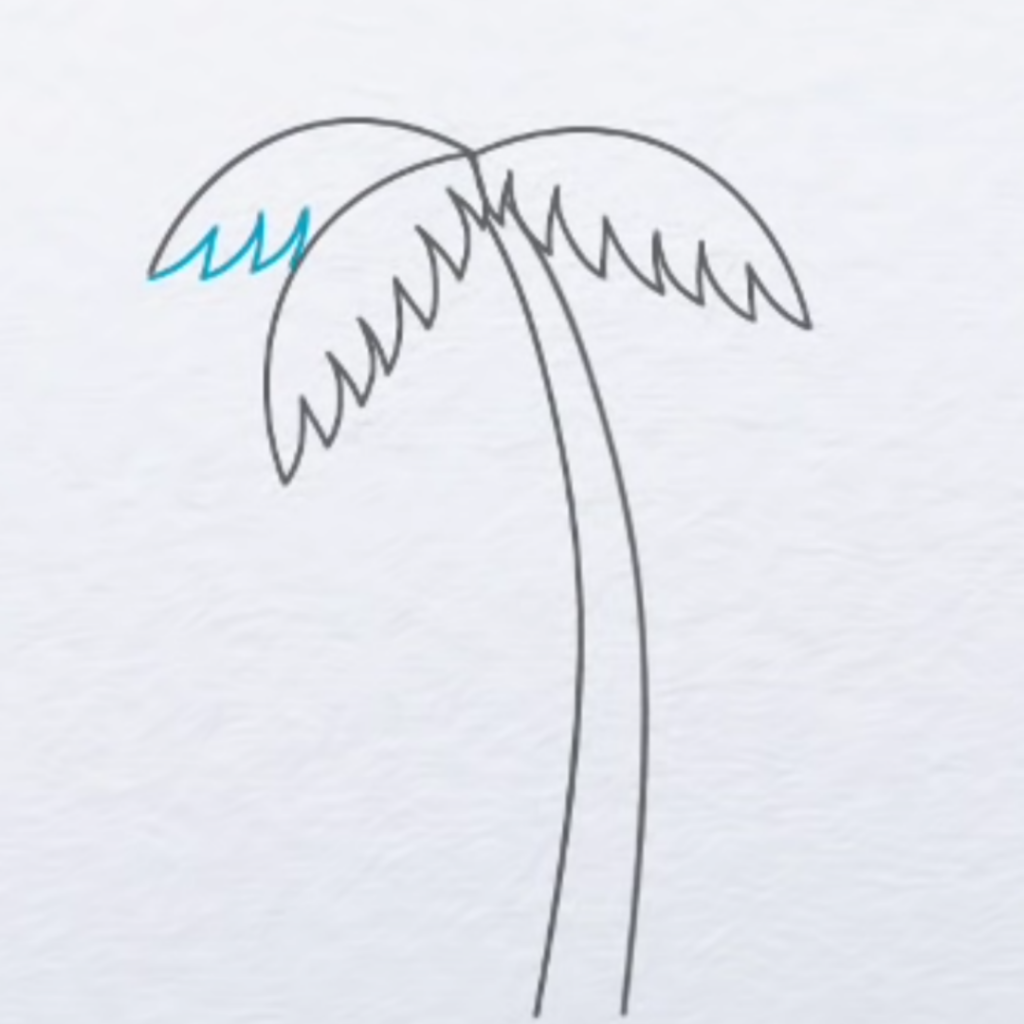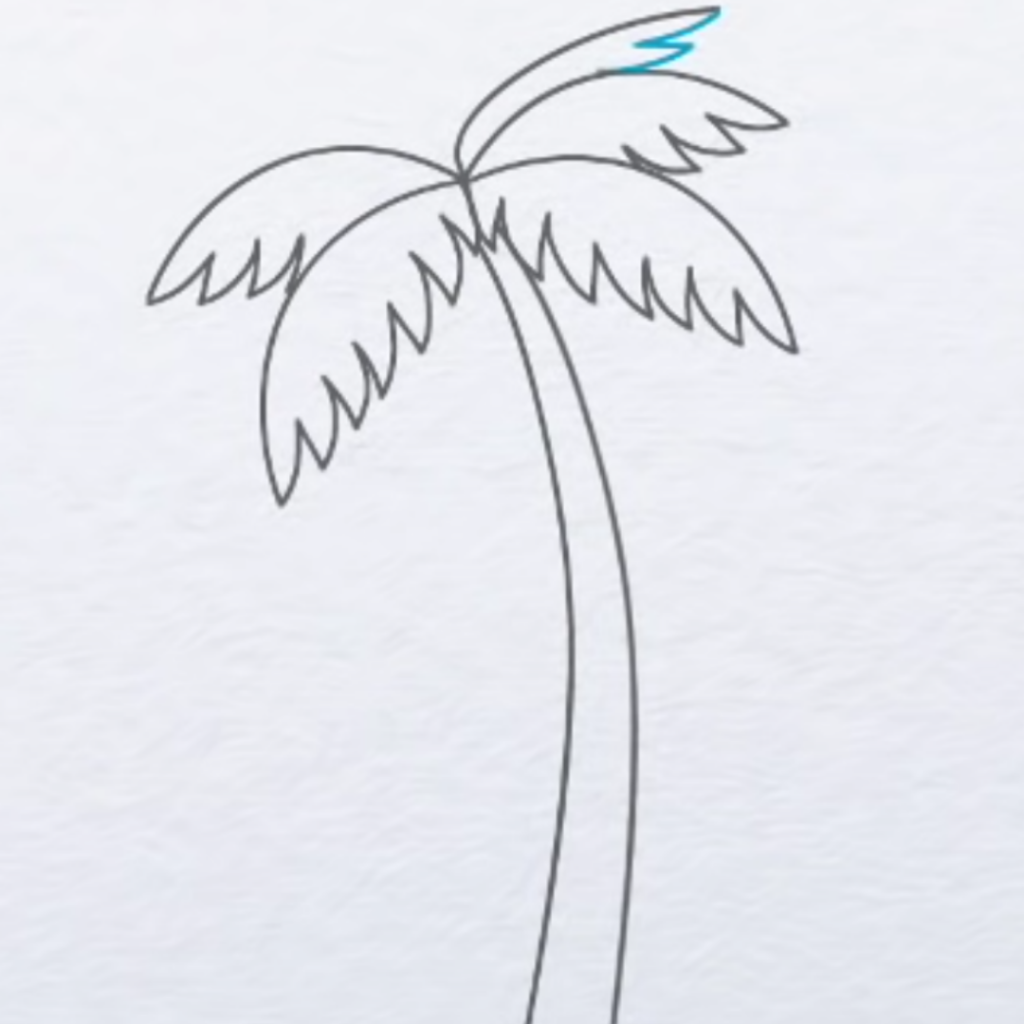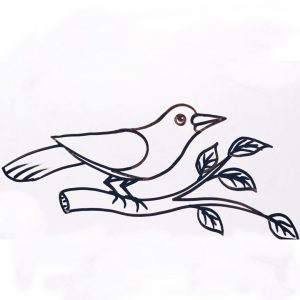Introduction
Palm tree drawing can be a rewarding and enjoyable artistic endeavor. Whether you want to create tropical landscapes or add a touch of paradise to your artwork, mastering palm tree drawing can elevate your skills to a professional level. In this article, we will explore the Top 10 easy steps that will help you to become proficient in drawing palm trees like a pro.

Importance of Palm Tree Drawing
Palm trees are iconic symbols of tropical beauty and relaxation. Having the skill to depict palm trees with accuracy and intricacy empowers you to craft mesmerizing masterpieces that encapsulate the very spirit of a tropical haven. Whether you’re an aspiring artist, an enthusiastic hobbyist, or a seasoned professional illustrator, the mastery of palm tree drawing bestows upon you a precious ability that enriches and expands your artistic range.
Benefits of Learning to Draw Palm Trees
Learning to draw palm trees offers several benefits beyond the aesthetic appeal. It helps improve your overall drawing skills by enhancing your understanding of shapes, perspective, shading, and composition. Additionally, the process of drawing palm trees promotes relaxation and mindfulness, allowing you to unleash your creativity while immersing yourself in a soothing artistic practice.

Step 1: Understanding the Anatomy of Palm Trees
Drawing any subject matter requires a solid understanding of its underlying structure and anatomy. The same applies to palm trees. Delve deep into the intricate world of palm tree anatomy, immersing yourself in its nuances, and acquire the mastery to artistically depict every element with unwavering fidelity. From the grandeur of the trunk to the elegance of the fronds, the allure of the coconuts, and even the concealed depths of their roots, your drawings will capture the very essence of these magnificent trees. This knowledge forms the foundation of realistic and detailed palm tree drawings.
- Identification of Parts of a Palm Tree
- To draw palm trees convincingly, it’s crucial to identify and understand the different parts that comprise them. These include the trunk (or stem), the crown shaft, the fronds (or leaves), the coconuts (if present), and the roots. Every individual part possesses its own unique attributes, contributing significantly to the overall aesthetics and visual appeal of the palm tree as a whole.
- Importance of Understanding Palm Tree Anatomy
- Understanding the anatomy of palm trees allows you to accurately represent their unique features, proportions, and growth patterns. It helps you create realistic and visually appealing drawings by capturing the essence of palm trees in a way that resonates with viewers. Moreover, this knowledge enables you to experiment with different styles and techniques while maintaining anatomical coherence.
- Techniques to Study Palm Tree Anatomy
- To study palm tree anatomy effectively, start by observing real palm trees in various settings, such as botanical gardens or natural environments. Direct your focus towards the form and framework of the trunk, the precise arrangement of the fronds, and the harmonious symmetry that encompasses the entirety of the palm tree. Additionally, use online resources, books, and tutorials to deepen your knowledge and refine your understanding of palm tree anatomy.

Step 2: Sketching Basic Shapes of Palm Trees
Sketching forms, is the initial stage of any drawing, allowing you to establish the overall structure and proportions. By sketching basic shapes, you can create a framework that guides the rest of your drawing process.
- Importance of Sketching
- Sketching helps you plan and visualize your artwork before adding intricate details. This artistic freedom grants you the opportunity to embark on an exploration of creative possibilities, enabling you to delve into diverse compositions and perspectives, pushing the boundaries of your artistic expression. Sketching also helps you identify any potential issues with proportions or layout early on, ensuring a smoother drawing process.
- Types of Basic Shapes
- In palm tree drawing, you can start with basic shapes such as circles, ovals, and triangles to represent the trunk, fronds, and coconuts. Circles and ovals can serve as the foundation for the crown shaft and the base of fronds, while triangles can be used to indicate the shape of individual fronds or leaflets.
- Tools for Sketching
- For sketching palm trees, you can use a range of tools depending on your preference. Pencils, particularly those with a soft lead (such as 2B or 4B), are a popular choice as they allow for easy erasing and shading. Mechanical pencils provide precise lines, while charcoal pencils can be used for more expressive and textured sketches. Experiment with different tools to find the one that suits your style best.
Gift:
Claim our premium worksheet practice book For Free (Only for you) :

Step 3: Adding Details to Basic Shapes
Once you have established the basic structure of your palm tree through sketching, it’s time to add details that bring your drawing to life. Details such as the texture of the trunk, the shape of individual fronds, and the presence of coconuts contribute to the realism and visual interest of your artwork.
- Types of Details
- When adding details, consider the texture and patterns unique to palm trees. Take careful note of the varying textures present in the trunk, discerning between its rough or smooth surfaces. Observe the fronds, with their delicate feather-like structure, and pay attention to the unique contours and shapes of the coconuts. Additionally, observe how the fronds emerge from the crown shaft and how they interact with the surrounding space.
- Techniques to Add Details
- To add details effectively, use techniques like hatching, cross-hatching, and stippling. Hatching involves creating parallel lines to convey texture or shading, while cross-hatching involves layering intersecting lines to achieve a denser or darker effect. Stippling, on the other hand, uses a series of dots to create texture or shading. Experiment with these techniques to find the ones that suit your style and desired level of detail.
- Importance of Paying Attention to Details
- Attention to detail is crucial in palm tree drawing as it contributes to the realism and accuracy of your artwork. By observing and replicating the intricate details of palm trees, you can create drawings that capture the essence of these magnificent trees. Details also add depth and visual interest to your drawings, making them more engaging for viewers.

Step 4: Shading Techniques for Palm Trees
The art of shading holds paramount importance in drawing, as it imbues your artwork with a sense of depth, volume, and dimension, breathing life into your creations. By applying shading techniques effectively, you can create the illusion of light and shadow, enhancing the three-dimensional quality of your palm tree drawings.
Importance of Shading
Shading is vital in palm tree drawing as it helps create a sense of realism and solidity. By understanding how light interacts with the different components of a palm tree, you can accurately portray the way shadows fall and highlights appear. Shading also adds depth and contrast, making your drawings visually compelling.
Types of Shading Techniques
Various shading techniques can be employed to enhance your palm tree drawings. These include:
- Graduated shading: This technique involves gradually transitioning from light to dark areas, creating a smooth and gradual change in value.
- Cross-contour shading: By following the contours of the palm tree’s surfaces, you can create shading that accentuates the form and volume.
- Cast shadow: Depicting the shadow cast by the palm tree adds depth and realism to the overall composition.
- Textured shading: Using a combination of lines, dots, or other marks, you can create textures that mimic the surface of the trunk, fronds, or coconuts.
Tools for Shading
To achieve effective shading, you can use a range of tools, such as pencils, charcoal, or graphite sticks. Soft or medium-grade pencils are ideal for creating smooth gradations, while charcoal provides a more expressive and textured effect. Tortillons, blending stumps, or even your fingers can be used to blend and smudge the shading for a softer and more seamless appearance.

Step 5: Color Theory for Palm Trees
Understanding color theory is essential for creating vibrant and visually appealing palm tree drawings. By applying color harmonies and understanding the principles of color mixing, you can bring your artwork to life with a sense of realism and atmosphere.
- Importance of Knowing Color Theory
- Color theory is the foundation of effective color usage in art. It allows you to create visually pleasing combinations, convey mood or atmosphere, and accurately represent the colors found in palm trees. By understanding color theory, you can elevate your drawings beyond black and white, adding a new dimension to your artistic expression.
- Color Wheel Basics
- The color wheel is a useful tool to understand color relationships. Nestled within the enchanting realm of colors resides a harmonious triad of primary hues: vibrant red, serene blue, and radiant yellow. Accompanying these are a trio of secondary colors, formed through the merging of primaries: orange, green, and violet. Lastly, the tertiary colors emerge as a fusion of primary and secondary shades, showcasing a spectrum of captivating possibilities. Complementary colors, which are opposite each other on the color wheel, create high contrast and visual impact when used together. Analogous colors found adjacent to each other on the color wheel, create harmony and a sense of unity.
- Combining Colors for Palm Trees
- When coloring palm trees, consider the different hues and tones found in real palm trees. Use varying shades of green for the fronds, taking into account the play of light and shadow. For the trunk, consider browns, grays, or even reddish tones to replicate the natural colors found in palm tree bark. Experiment with color combinations to achieve the desired effect, keeping in mind the principles of color harmony.

Step 6: Different Types of Palm Trees
Palm trees come in various types, each with its unique characteristics and visual appeal. By familiarizing yourself with the different types of palm trees, you can broaden your artistic repertoire and create diverse palm tree drawings.
- Identification of Common Types of Palm Trees
- The vast world of palm trees encompasses a multitude of species, each possessing its own individualistic allure and distinguishing characteristics. Common types include Coconut Palm, Date Palm, Fan Palm, Queen Palm, and Sago Palm. Research and study these different types to understand their specific characteristics and visual cues.
- Characteristics of Each Type
- Each type of palm tree has specific attributes that differentiate it from others. These defining traits encompass a myriad of aspects, ranging from the unique contour and dimensions of the fronds to the intricate arrangement of leaflets, the notable presence or absence of coconuts, and the overarching growth patterns exhibited by each individual palm tree. Understanding these characteristics allows you to accurately depict different palm tree species in your drawings.
- Drawing Different Types of Palm Trees
- When drawing different types of palm trees, pay attention to the specific features that define each type. For example, Fan Palms have fan-shaped fronds with distinct segments, while Date Palms have feather-like fronds with numerous leaflets. Capture these unique characteristics through careful observation and accurate representation.

Step 7: Composition of Palm Trees
Composition refers to the arrangement and organization of elements within a drawing. By considering composition, you can create visually pleasing and well-balanced palm tree drawings that effectively communicate your artistic vision.
- Importance of Composition
- A well-composed palm tree drawing guides the viewer’s eye and creates a sense of harmony. It ensures that the various elements within the drawing are balanced, proportionate, and aesthetically pleasing. The composition also allows you to create a focal point and convey a particular mood or atmosphere.
- Techniques to Create Balance in Drawing
- To create a balanced composition, consider techniques such as the rule of thirds, leading lines, and framing. The rule of thirds involves dividing the drawing area into a grid of nine equal sections and placing important elements along the intersections or lines. Leading lines, such as the trunk or the direction of fronds, can guide the viewer’s gaze throughout the drawing. Framing involves using surrounding elements to create a visual frame that draws attention to the palm tree.
- Tools for Composing Palm Trees
- When composing palm tree drawings, consider the placement of other elements such as the horizon line, background elements, or additional flora. These elements can enhance the overall composition and context of the palm tree. Experiment with different arrangements and perspectives to find the composition that best suits your artistic intention.

Step 8: Tricks to Create Realistic Palm Trees
Realism in palm tree drawing involves capturing the intricate details and nuances that make palm trees visually convincing. By employing specific techniques, you can add realism to your drawings, making them appear lifelike and engaging.
Importance of Realistic Drawings
Realistic drawings evoke a sense of authenticity and believability. By creating realistic palm tree drawings, you can transport viewers to a tropical setting and allow them to immerse themselves in the artwork. Realism also showcases your technical skills and attention to detail, demonstrating your ability to recreate nature’s beauty.
Techniques to Add Realism to Drawings
To add realism to palm tree drawings, consider the following techniques:
- Observation: Study palm trees in real-life or reference photographs, paying close attention to their unique characteristics, textures, and lighting conditions.
- Layering: Build up your drawing in layers, gradually adding details, shading, and color to create depth and dimension.
- Texturing: Use techniques such as cross-hatching or stippling to create texture and mimic the rough or smooth surfaces of the trunk, fronds, and coconuts.
- Light and shadow: Observe how light interacts with the palm tree and replicate the resulting shadows and highlights accurately.
- Reflections: If drawing palm trees near water, consider adding reflections to enhance the realism and sense of the environment.
Tools for Creating Realistic Palm Trees
To create realistic palm tree drawings, use tools that allow for precise control and detailed rendering. Colored pencils, pastels, or even digital drawing software can provide the necessary flexibility and control to capture intricate details and textures. Experiment with different tools and techniques to achieve the level of realism you desire.

Step 9: Creating Palm Trees in Different Settings
Palm trees are found in various settings, from tropical landscapes to urban environments. By practicing drawing palm trees in different settings, you can expand your artistic versatility and create drawings that reflect diverse contexts.
- Drawing Palm Trees in Landscapes
- Drawing palm trees in landscapes involves considering the surrounding elements, such as other vegetation, bodies of water, or architectural structures. Capture the overall atmosphere and create a sense of place by incorporating appropriate elements and paying attention to scale and perspective.
- Drawing Palm Trees in Seascapes
- Seascapes provide a unique backdrop for palm tree drawings, with the interplay of palm trees against the ocean or beach. Allow your artistic senses to be captivated by the graceful ebb and flow of the water, the tangible texture of the sand beneath your fingertips, and the mesmerizing synergy between the palm trees and the enchanting coastal ambiance that surrounds them. Depicting the play of light and reflections can add depth and visual interest to your seascapes.
- Drawing Palm Trees in Urban Settings
- Palm trees are often seen in urban environments, lining streets, parks, or public spaces. When drawing palm trees in urban settings, consider the surrounding architecture, people, and elements of urban life. Effortlessly capture the harmonious blend of nature’s beauty and the intricate tapestry of human creations, infusing your drawings with an exquisite blend of liveliness and distinct personality.

Step 10: Practicing Perfect Palm Tree Drawing
Mastery of any skill requires consistent practice and dedication. By incorporating regular practice sessions into your routine, you can improve your palm tree drawing skills and progress toward achieving mastery.
Importance of Practicing
Practice helps refine your technique, enhance your observation skills, and develop a personal style. Regular practice sessions allow you to experiment, learn from mistakes, and gradually improve your understanding of palm tree drawing. The crucial element to attain the desired pinnacle of mastery lies within the realm of consistent practice, diligently refining your skills, and nurturing your artistic abilities.
Techniques to Improve Drawing Skills
To improve your palm tree drawing skills, consider the following techniques:
- Study: Continuously study palm trees and their various characteristics, observing different species, lighting conditions, and perspectives.
- Draw from life: Whenever possible, draw palm trees from real-life observation rather than relying solely on reference images. This practice enhances your ability to capture the subtleties of form, texture, and lighting.
- Break it down: Focus on specific aspects of palm trees in isolated studies. For example, dedicate a practice session to drawing just fronds or coconuts. This approach allows for focused learning and mastery of individual elements.
- Seek feedback: Share your drawings with peers, mentors, or online communities to receive constructive feedback and insights for improvement. Embrace critiques as opportunities for growth and learning.
- Experiment: Step out of your comfort zone and explore different styles, techniques, and mediums. Experimentation broadens your artistic horizons and encourages creative exploration.

Maintaining Consistency in Practice
To maintain consistency in practice, establish a dedicated schedule or routine for drawing palm trees. Set aside specific time blocks for practice sessions, ensuring that you prioritize and commit to your artistic development. Create a supportive environment that fosters creativity and minimizes distractions, allowing you to fully engage in your practice.
Conclusion
Mastering the art of palm tree drawing is an enjoyable and rewarding journey. Embarking on the journey outlined in this article, and adhering to the ten carefully crafted steps, will enable you to cultivate the essential skills and techniques required to craft awe-inspiring and remarkably realistic palm tree drawings. Remember to pay attention to palm tree anatomy, sketch basic shapes, add details, employ shading and color theory, explore different types of palm trees, consider composition, strive for realism, experiment with different settings, practice consistently, and never stop learning.
Recap of the 10 Steps:
- Understanding the Anatomy of Palm Trees
- Sketching Basic Shapes of Palm Trees
- Adding Details to Basic Shapes
- Shading Techniques for Palm Trees
- Color Theory for Palm Trees
- Different Types of Palm Trees
- Composition of Palm Trees
- Tricks to Create Realistic Palm Trees
- Creating Palm Trees in Different Settings
- Practicing to Perfect Palm Tree Drawing
Bonus:
You may check out our most helpful article about how you can help your child to do extremely well in drawing https://bloggchain.com/easy-lotus-flower-drawing-in-2023/
Significance of Mastering Palm Tree Drawing
Mastering palm tree drawing allows you to express your creativity, capture the beauty of nature, and create artwork that resonates with viewers. It opens doors to new artistic possibilities, whether for personal enjoyment or professional pursuits. Through dedication and practice, you can achieve mastery and bring palm trees to life on paper.
Encouragement to Continue practicing
Embarking on the journey to master palm tree drawing requires patience, perseverance, and a genuine passion for art. Embrace the hurdles that come your way, revel in the milestones you achieve, and discover sheer delight within the very process itself. Remember that every stroke of the pencil or brush brings you closer to your goals. Persist in your practice, fearlessly explore new horizons, and courageously push the limits of your artistic abilities. By embracing this path, you will embark on an everlasting voyage of evolution and metamorphosis, continually unfolding as an artist.
FAQs
- How long does it take to master palm tree drawing?
- The time required to master palm tree drawing varies from person to person. It depends on factors such as the amount of practice, dedication, and innate artistic ability. Through unwavering dedication to regular practice and a steadfast commitment to perpetual learning, steady progress can be achieved and amplified over the course of time.
- Is it necessary to have drawing skills to master palm tree drawing?
- While having prior drawing skills can be beneficial, anyone can learn and master palm tree drawing with practice and dedication. Start with basic shapes and gradually build your skills through observation, study, and experimentation.
- Can palm tree drawings be used for commercial purposes?
- Yes, palm tree drawings can be used for commercial purposes, such as illustrations for books, magazines, or merchandise. However, it is important to respect copyright laws and obtain proper authorization if using reference materials or incorporating trademarked elements.
- What is the best way to practice palm tree drawing?
- The best way to practice palm tree drawing is through a combination of observation, study, and hands-on drawing. Start by observing palm trees in real life or reference images, then break down the elements into basic shapes and gradually add details. Regular practice sessions and seeking feedback can further enhance your skills.
- Are there free resources available to learn palm tree drawing?
- Yes, there are numerous free resources available online to learn palm tree drawing. An abundance of resources awaits in the form of websites, tutorials, YouTube videos, and online art communities, all offering invaluable insights, techniques, and meticulous step-by-step instructions. Seize the opportunity to leverage these resources, enriching your learning journey and broadening the horizons of your artistic expertise.
Sponsored By:
Check out the best and most affordable digital marketing services that can take your business to the next level https://elonmusktrillion.com/




Pingback: New Exciting Guide to Dog Drawing in 2023 - Bloggchain